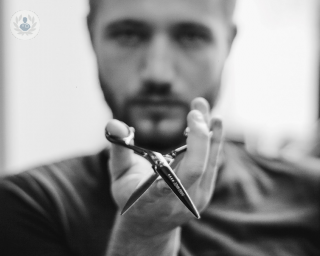What is foreskin and what are the most common foreskin-related problems?
The foreskin is a layered fold of skin which covers and protects the end of the penis in uncircumcised children and adults. While the foreskin does not need any special care in infancy or early childhood, later on in life it is important to correctly wash and care for the foreskin in order to prevent problems. Problems can include swelling, infection, tightness, irritation, and dryness.

What are the causes of foreskin problems?
In young children, the foreskin is attached to the head of the penis by a membrane called the synechia. Over time, this membrane naturally dissolves. Until this membrane has dissolved, the foreskin should not be forced back or pushed back until it naturally happens – young boys usually discover they can do this by themselves.
In some cases, the foreskin may not be able to be pulled back, caused by something called phimosis. This occurs when the opening of the foreskin is too small and it cannot be properly retracted. The foreskin should start to retract between the ages of two and six – before that, it’s not usually a cause for concern. In babies, if the foreskin is red and swollen, this could be connected to nappy rash or an infection.
In teenagers and adults (those whose foreskin is able to be pulled back) problems can be caused by a number of triggers, including STIs, infection (such as balanitis or thrush), or injury. It is important to note the signs of foreskin problems so your doctor can correctly determine the cause.
What are the signs of problems with the foreskin?
Signs of problems with the foreskin include:
- pain during urination
- itchiness or a rash
- inability to pull back the foreskin
- pain during intercourse
- redness
- soreness
- swelling of the penis
- dryness
- split or bleeding skin
Visit a doctor to have your symptoms related to problems with the foreskin checked and investigated.
How are foreskin problems treated?
Treatment for foreskin problems depend on the issue with the foreskin itself. Dryness, for example, can be managed with creams, lotions, or ointments as indicated by your doctor, or through oral medication. Other problems, such as balanitis, can be treated with medication and creams.
In some cases in children, such as with phimosis, a procedure may be performed to move back the foreskin. In certain cases, usually in adults, circumcision may be performed if the foreskin is causing issues. This is only performed in cases where it is deemed medically necessary. There is no medical need for routine circumcision in children.
Can foreskin problems be prevented?
It is important to properly care for the foreskin in order to reduce the chances of foreskin problems developing. In order to help prevent foreskin problems, you should do the following:
- change your underwear regularly
- wear loose underwear, which allows for circulation of air
- avoid hygiene products which are heavily or artificially scented
- regularly clean your foreskin, washing daily with warm water, and cleaning underneath the foreskin
- use protection during sex to reduce the risk of catching an STI and avoid unwanted bacteria
Which specialist treats foreskin problems?
A urologist treats and manages conditions affecting the male reproductive system. In children, a paediatric urologist is usually consulted.
When and how can I get my foreskin removed completely?
If the patient is experiencing pain or other frequent problems when urinating, then surgical removal/circumcision will be considered.
When should you call a doctor for foreskin problems?
Patients should seek medical advice for their foreskin problems if they notice the following:
- difficulty urinating;
- burning sensation when urinating;
- foreskin progressively become more painful;
- they cannot return the foreskin to its original position.
Is there an age limit on who can be circumcised?
No. Any men of any age can be circumcised.
02-20-2018 04-25-2023Foreskin problems
Mr Nav Johal - Paediatric urology
Created on: 02-20-2018
Updated on: 04-25-2023
Edited by: Conor Lynch
What is foreskin and what are the most common foreskin-related problems?
The foreskin is a layered fold of skin which covers and protects the end of the penis in uncircumcised children and adults. While the foreskin does not need any special care in infancy or early childhood, later on in life it is important to correctly wash and care for the foreskin in order to prevent problems. Problems can include swelling, infection, tightness, irritation, and dryness.

What are the causes of foreskin problems?
In young children, the foreskin is attached to the head of the penis by a membrane called the synechia. Over time, this membrane naturally dissolves. Until this membrane has dissolved, the foreskin should not be forced back or pushed back until it naturally happens – young boys usually discover they can do this by themselves.
In some cases, the foreskin may not be able to be pulled back, caused by something called phimosis. This occurs when the opening of the foreskin is too small and it cannot be properly retracted. The foreskin should start to retract between the ages of two and six – before that, it’s not usually a cause for concern. In babies, if the foreskin is red and swollen, this could be connected to nappy rash or an infection.
In teenagers and adults (those whose foreskin is able to be pulled back) problems can be caused by a number of triggers, including STIs, infection (such as balanitis or thrush), or injury. It is important to note the signs of foreskin problems so your doctor can correctly determine the cause.
What are the signs of problems with the foreskin?
Signs of problems with the foreskin include:
- pain during urination
- itchiness or a rash
- inability to pull back the foreskin
- pain during intercourse
- redness
- soreness
- swelling of the penis
- dryness
- split or bleeding skin
Visit a doctor to have your symptoms related to problems with the foreskin checked and investigated.
How are foreskin problems treated?
Treatment for foreskin problems depend on the issue with the foreskin itself. Dryness, for example, can be managed with creams, lotions, or ointments as indicated by your doctor, or through oral medication. Other problems, such as balanitis, can be treated with medication and creams.
In some cases in children, such as with phimosis, a procedure may be performed to move back the foreskin. In certain cases, usually in adults, circumcision may be performed if the foreskin is causing issues. This is only performed in cases where it is deemed medically necessary. There is no medical need for routine circumcision in children.
Can foreskin problems be prevented?
It is important to properly care for the foreskin in order to reduce the chances of foreskin problems developing. In order to help prevent foreskin problems, you should do the following:
- change your underwear regularly
- wear loose underwear, which allows for circulation of air
- avoid hygiene products which are heavily or artificially scented
- regularly clean your foreskin, washing daily with warm water, and cleaning underneath the foreskin
- use protection during sex to reduce the risk of catching an STI and avoid unwanted bacteria
Which specialist treats foreskin problems?
A urologist treats and manages conditions affecting the male reproductive system. In children, a paediatric urologist is usually consulted.
When and how can I get my foreskin removed completely?
If the patient is experiencing pain or other frequent problems when urinating, then surgical removal/circumcision will be considered.
When should you call a doctor for foreskin problems?
Patients should seek medical advice for their foreskin problems if they notice the following:
- difficulty urinating;
- burning sensation when urinating;
- foreskin progressively become more painful;
- they cannot return the foreskin to its original position.
Is there an age limit on who can be circumcised?
No. Any men of any age can be circumcised.


Phimosis: when should you consider circumcision?
By Mr Jaspal Virdi
2024-11-21
Having phimosis isn't something to worry about, and for many young boys, a "wait-and-see" approach can be all that's needed until the skin around the glans naturally loosens. However, for others, a bit more attention is required to help the foreskin move freely, and in some instances, circumcision is needed. Urological surgeon, Mr Jaspal Virdi, explains when you should consider as it a treatment option for a tight foreskin. See more


Circumcision: An expert guide
By Miss Marie-Klaire Farrugia
2024-11-21
Revered consultant paediatric urologist and paediatric and neonatal surgeon Miss Marie-Klaire Farrugia offers expert guidance on circumcision in babies and children, including when it is indicated and what to expect from the recovery period to follow. See more


When should my child's foreskin retract?
By Miss Marie-Klaire Farrugia
2024-11-21
Leading consultant paediatric urologist, Miss Marie-Klaire Farrugia talks about the most common foreskin problems that you may see in your child. See more


Male foreskin problems: everything you need to know
By Dr Emily Lord
2024-11-20
Male foreskin issues can impact individuals at any stage of life, from infancy to adulthood. Understanding common foreskin issues, their causes, and available management options is essential for maintaining optimal male genital health. Leading consultant in sexual and reproductive health Dr Emily Lord explains everything you need to know about male foreskin problems. See more
Experts in Foreskin problems
-
Mr Jaspal Virdi
UrologyExpert in:
- Prostate cancer
- Paediatric urology
- Benign prostate enlargement
- Rezūm
- Foreskin problems
- Scrotal swelling
-
Ms Johanna Thomas
UrologyExpert in:
- Paediatric urology
- Undescended testicle (Cryptorchidism)
- Foreskin problems
- Urinary tract infection
- Laser lithotripsy
- Kidney stones
-
Mr Paul Hadway
UrologyExpert in:
- Foreskin problems
- Urethral stricture
- Circumcision
- Andrology
- Erectile dysfunction
- Prostate
-
Mr Alexander Cho
Paediatric urologyExpert in:
- Paediatric urology
- Kidney stones
- Foreskin problems
- Bladder problems
- Undescended testicle (Cryptorchidism)
- Hydronephrosis
-
Mr Nav Johal
Paediatric urologyExpert in:
- Hydronephrosis
- Foreskin problems
- Undescended testicle (Cryptorchidism)
- Vesicoureteral reflux (VUR) (kidney reflux)
- Hypospadias
- Urinary tract infection
- See all

The Portland Hospital - part of HCA Healthcare
The Portland Hospital - part of HCA Healthcare
205 - 209 Great Portland St. W1W 5AH
No existe teléfono en el centro.
By using the telephone number provided by TOP DOCTORS, you automatically agree to let us use your phone number for statistical and commercial purposes. For further information, read our Privacy Policy
Top Doctors

Great Ormond Street Hospital
Great Ormond Street Hospital
Great Ormond Street. WC1N 3JH
No existe teléfono en el centro.
By using the telephone number provided by TOP DOCTORS, you automatically agree to let us use your phone number for statistical and commercial purposes. For further information, read our Privacy Policy
Top Doctors

The Lister Hospital - part of HCA Healthcare
The Lister Hospital - part of HCA Healthcare
Chelsea Bridge Road, London
No existe teléfono en el centro.
By using the telephone number provided by TOP DOCTORS, you automatically agree to let us use your phone number for statistical and commercial purposes. For further information, read our Privacy Policy
Top Doctors
-
The Portland Hospital - part of HCA Healthcare
205 - 209 Great Portland St. W1W 5AH, Central LondonExpert in:
- Neurological spinal surgery
- Orthopaedic spinal surgery
- Maternity care
- Pregnancy
- Scoliosis
- In vitro fertilisation (IVF)
-
Great Ormond Street Hospital
Great Ormond Street. WC1N 3JH, Central LondonExpert in:
- Cancer
- Paediatric neurosurgery
- Paediatrics
-
The Lister Hospital - part of HCA Healthcare
Chelsea Bridge Road, London , Central LondonExpert in:
- Cancer
- Cardiology
- Orthopaedic surgery
- Pregnancy
- Physiotherapy
- Women’s health
- See all
- Most viewed diseases, medical tests, and treatments
- Undescended testicle (Cryptorchidism)
- Testicular ultrasound
- Minimal access surgery (keyhole surgery)
- NanoKnife
- Vaginal dryness
- Pelvic pain syndrome
- Kidney stones
- Medicolegal
- Women's health
- Robotic surgery







